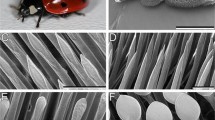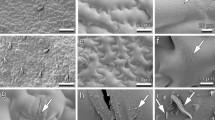Abstract
The shear adhesive force of four non-climbing cockroaches (Blatta orientalis Linnaeus, 1758) was investigated by the use of a centrifugal machine, evaluating the shear safety factor (adhesion force divided by body weight) on six surfaces (steel, aluminium, copper, two sandpapers and a common paper sheet) having different roughness. The adhesive system of Blatta orientalis was characterized by means of a field emission scanning electron microscope and the surface roughness was determined by an atomic force microscope. The cockroach maximum shear safety factor, or apparent friction coefficient, is determined to be 12.1 on the less rough of the two sandpapers, while its minimum value is equal to 1.9 on the steel surface. A two-sample Student t analysis has been conducted in order to evaluate the significance of the differences among the obtained shear safety factors due to both roughness and chemistry. An interesting correlation between cockroach shear adhesion and surface roughness emerges with a threshold mechanism dictated by the competition between claw tip radius and roughness, indicating that the best adhesion is obtained for roughness larger than the claw tip radius.





Similar content being viewed by others
References
Stork NE (1980) Experimental analysis of adhesion of Chrysolina polita (Chrysomelidae: Coleoptera) on a variety of surfaces. J Exp Biol 88:91–107
Eisner T, Aneshansley DJ (2000) Defense by foot adhesion in a beetle (Hemisphaerota cyanea). Proc Natl Acad Sci USA 97:6568–6573
Voigt D, Schuppert JM, Dattinger S, Gorb SN (2008) Sexual dimorphism in the attachment ability of the Colorado potato beetle Leptinotarsa decemlineata (Coleoptera: Chrysomelidae) to rough substrates. J Insect Physiol 54:765–776
Dai Z, Gorb SN, Schwarz U (2002) Roughness-dependent friction force of the tarsal claw system in the beetle Pachnoda marginata (Coleoptera Scarabeiddae). J Exp Biol 205:2479–2488
Bullock JMR, Drechsler P, Federle W (2008) Comparison of smooth and hairy attachment pads in insects: friction, adhesion and mechanisms for direction-dependence. J Exp Biol 211:3333–3343
Eigenbrode SD, Jetter R (2002) Attachment to plant surface waxes by an insect predator. Integr Comput Biol 42:1091–1099
Wigglesworth VB (1987) How does a fly cling to the under surface of a glass sheet? J Exp Biol 129:373–376
Dixon AFG, Croghan PC, Gowing RP (1990) The mechanism by which aphids adhere to smooth surfaces. J Exp Biol 152:243–253
Lees AD, Hardie J (1988) The organs of adhesion in the aphid Megoura viciae. J Exp Biol 136:209–228
Dixon AFG, Croghan PC, Gowing RP (1990) The mechanism by which aphids adhere to smooth surfaces. J Exp Biol 152:243–253
Gorb SN, Gorb EV, Kastner V (2001) Scale effects on the attachment pads and friction forces in syrphid flies (Diptera Syrphidae). J Exp Biol 204:1421–1431
Walker G, Yue AB, Ratcliffe J (1985) The adhesive organ of the blowfly, Calliphora vomitoria: a functional approach (Diptera Calliphoridae). J Zoolog Lond A 205:297–307
Voigt D (2005) Untersuchungen zur Morphologie, Biologie und Ökologie der räuberischen Weichwanze Dicyphus errans Wolff (Heteroptera, Miridae, Bryocorinae). Dissertation, Technische Universität Dresden
Federle W, Rohrseitz K, Holldobler B (2000) Attachment forces of ants measured with a centrifuge: better ‘wax-runners’ have a poorer attachment to a smooth surface. J Exp Biol 203:505–512
Federle W, Riehle M, Curtis ASG, Full RJ (2002) An integrative study of insect adhesion: mechanics and wet adhesion of pretarsal pads in ants. Integr Comput Biol 42:100–1106
Brainerd EL (1994) Adhesion force of ants on smooth surfaces. Am Zool 34:128
Federle W, Baumgartner W, Hölldobler B (2003) Biomechanics of ant adhesive pads: frictional forces are rate- and temperature-dependent. J Exp Biol 206:67–74
Arnold JW (1974) Adaptive features on the tarsi of cockroaches (Insecta: Dictyoptera). Int J Insect Morphol Embryol 3:317–334
Bell WJ, Roth LM, Nalepa CA (2007) Cockroaches. Ecology, behavior and natural history. The Johns Hopkins University Press, Baltimore
Van Casteren A, Codd JA (2008) Foot morphology and substrate adhesion in the Madagascan hissing cockroach, Gromphadorhina portentosa. J Insect Sci 10:1–11
Clemente CJ, Federle W (2008) Pushing versus pulling: division of labour between tarsal attachment pads in cockroaches. Proc R Soc Lond B, Biol Sci 275:1329–1336
Clemente CJ, Dirks JH, Barbero DR, Steiner U, Federle W (2009) Friction ridges in cockroach climbing pads: anisotropy of shear stress measured on transparent, microstructured substrates. J Comp Physiol A 195:805–814
Frazier SF, Larsen GS, Neff D, Quimby L, Carney M, DiCaprio RA, Zill SN (1999) Elasticity and movements of the cockroach tarsus in walking. J Comp Physiol A 185:157–172
Roth LM, Willis ER (1952) Tarsal structure and climbing ability of cockroaches. J Exp Zool 119:483–517
Niederegger S, Gorb SN (2006) Friction and adhesion in the tarsal and metatarsal scopulae of spiders. J Comp Physiol A 192:1223–1232
Kesel AB, Martin A, Seidl T (2004) Getting a grip on spider attachment: an AFM approach to microstructure adhesion in arthropods. Smart Mater Struct 13:512–518
Kesel AB, Martin A, Seidl T (2003) Adhesion measurements on the attachment devices of the jumping spider Evarcha arcuata. J Exp Biol 206:2733–2738
Autumn K, Peattie AM (2002) Mechanisms of adhesion in geckos. Integr Comput Biol 42:1081–1090
Pugno NM, Lepore E, Toscano S, Pugno F (2011) Adhesion force-displacement curves of living geckos. J Adhes 87:1059–1072
Autumn K, Dittmore A, Santos D, Spenko M, Cutkosky M (2006) Frictional adhesion: a new angle on gecko attachment. J Exp Biol 209:3569–3579
Pugno NM, Lepore E (2008) Living tokay geckos display adhesion times following the Weibull statistics. J Adhes 89:949–962
Pugno NM, Lepore E (2008) Observation of optimal gecko’s adhesion on nanorough surfaces. Biosystems 94:218–222
Lepore E, Antoniolli F, Buono M, Brianza S, Carpinteri A, Pugno N (2008) Preliminary experiments on adhesion of in vivo geckos. J Nanomater 194524. Special issue on nanomechanics and nanostructructured multifunctional materials: experiments, theories, and simulations. doi:10.1155/2008/194524
Huber G, Gorb SN, Hosoda N, Spolenak R, Arzt E (2007) Influence of surface roughness on gecko adhesion. Acta Biomater 3:607–610
Irschick DJ, Austin CC, Petren K, Fisher R, Losos JB, Ellers O (1996) A comparative analysis of clinging ability among pad-bearing lizards. Biol J Linn Soc 59:21–35
Pugno N (2007) Towards a Spiderman suit: large invisible cables and self-cleaning releasable super-adhesive materials. J Phys Condens Matter 19:395001
Pugno N (2008) Spiderman gloves. Nano Today 3:35–41
Varenberg M, Pugno N, Gorb S (2010) Spatulate structures in biological fibrillar adhesion. Soft Matter 6:3269–3272
Beutel RG, Gorb SN (2001) Ultrastructure of attachment specializations of hexapods (Arthropoda): evolutionary patterns inferred from a revised ordinal phylogeny. J Zoolog Syst Evol Res 39:177–207
Peattie AM (2009) Functional demands of dynamic biological adhesion: an integrative approach. J Comp Physiol B 179:231–239
Gorb SN, Scherge M (2000) Biological microtribology: anisotropy in frictional forces of orthopteran attachment pads reflects the ultrastructure of a highly deformable material. Proc R Soc Lond B, Biol Sci 267:1239–1244
Zani PA (2000) The comparative evolution of lizard claw and toe morphology and clinging performance. J Evol Biol 13:316–325
Cannatella DC, de Queiroz K (1989) Phylogenetic systematics of the anoles: is a new taxonomy warranted? Syst Zool 38:57–69
Guyer C, Savage JM (1986) Cladistic relationships among anoles (Sauria: Iguanidae). Syst Zool 35:509–531
Ruibal R, Ernst V (1979) The structure of the digital setae of lizards. J Morphol 117:271–294
Beutel RG, Gorb SN (2001) Ultrastructure of attachment specializations of hexapods (Arthropoda): evolutionary patterns inferred from a revised ordinal phylogeny. J Zoolog Syst Evol Res 39:177–207
Heethoff M, Koerner L (2007) Small but powerful: the oribatid mite Archegozetes longisetosus Aoki (Acari, Oribatida) produces disproportionately high forces. J Exp Biol 210:3036–3042
Betz O (2002) Performance and adaptive value of tarsal morphology in rove beetles of the genus Stenus (Coleoptera Staphylinidae). J Exp Biol 205:1097–1113
Drechsler P, Federle W (2006) Biomechanics of smooth adhesive pads in insects: influence of tarsal secretion on attachment performance. J Comp Physiol A 192:1213–1222
Betz O (2010) Adhesive exocrine glands in insects: morphology, ultrastructure, and adhesive secretion. In: Byern J, Grunwald I (eds) Biological adhesive systems. From nature to technical and medical application. Springer, Berlin, pp 111–152
Gorb SN, Beutel RG, Gorb EV, Jiao Y, Kastner V, Niederegger S, Popov VL, Scherge M, Schwarz U, Votsch W (2002) Structural design and biomechanics of friction-based releasable attachment devices in insects. Integr Comput Biol 42:1127–1139
Bitar LA, Voigt D, Zebitz CPW, Gorb SN (2010) Attachment ability of the codling moth Cydia pomonella L. to rough substrates. J Insect Physiol 56:1966–1972
Persson BNJ (2007) Biological adhesion for locomotion on rough surfaces: basic principles and a theorist’s view. Mater Res Soc Bull 32:486–490
Bullock JMR, Federle W (2009) Division of labour and sex differences between fibrillar, tarsal adhesive pads in beetles: effective elastic modulus and attachment performance. J Exp Biol 212:1876–1888
Tolke S (2005) Bau und Funktion der Haftstrukturen an den Tarsen ausgewahlter Heyeropterenarten. Diploma thesis, Tubingen, Germany
Bullock JMR, Federle W (2010) The effect of surface roughness on claw and adhesive hair performance in the dock beetle Gastrophysa viridula. Insect Sci 00:1–7. doi:10.1111/j.1744-7917.2010.01369.x
Acknowledgements
NMP is supported by the European Research Council (ERC Starting Grant BIHSNAM on “Bioinspired hierarchical super-nanomaterials” and ERC Proof of Concept REPLICA) and by the Graphene Flagship. The authors would like to thank F. Casini for his advice and for providing the insects, M. Binda at the LabSamp of Politecnico di Milano for her helpfulness in the surface analysis and E. Enrico at NanoFacility Piemonte, INRiM, a laboratory supported by Compagnia di San Paolo, for his help in performing the FESEM micrographs.
Author information
Authors and Affiliations
Corresponding author
Rights and permissions
About this article
Cite this article
Lepore, E., Brambilla, P., Pero, A. et al. Observations of shear adhesive force and friction of Blatta orientalis on different surfaces. Meccanica 48, 1863–1873 (2013). https://doi.org/10.1007/s11012-013-9796-6
Received:
Accepted:
Published:
Issue Date:
DOI: https://doi.org/10.1007/s11012-013-9796-6




